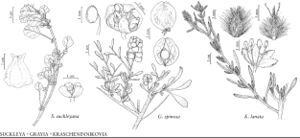Grayia spinosa
in A. P. de Candolle and A. L. P. P. de Candolle., Prodr. 13(2): 119. 1849.
Plants dioecious (rarely monoecious). Stems 3–10 (–15) dm, becoming reddish-brown with whitish ribs exfoliating in strips, older bark dark gray. Leaves of main-stems 1–2.5 (–4.2) cm × 1.5–6 (–10) mm; blade green, apex often whitish. Staminate flowers: perianth segments ± enclosing stamens, 1.5–2 mm; filaments shorter than anthers. Pistillate flowers: stigma protruding through opening in covering formed by accrescent bracts. Fruiting bracts wholly connate, sessile, orbicular to broadly elliptic, 7.5–14 × 6–12 mm, base often abruptly cuneate and stipelike, margins entire, apex retuse, glabrous; wing somewhat thickened near margin, yellowish green, whitish, or pink to red-tinged, smooth, glabrous. Utricles brown, 1.5–2 mm. 2n = 36.
Phenology: Flowering spring–summer.
Habitat: Valleys, foothills, dry, alkaline or scarcely alkaline soils, sagebrush, shadscale, and creosote bush communities
Elevation: 500-2400 m
Distribution

Ariz., Calif., Colo., Idaho, Mont., Nev., Oreg., Utah, Wash., Wyo.
Discussion
Grayia spinosa is rarely a codominant. Its fruits are still present through July.
Selected References
None.
Lower Taxa
"dm" is not declared as a valid unit of measurement for this property."dm" is not declared as a valid unit of measurement for this property.
